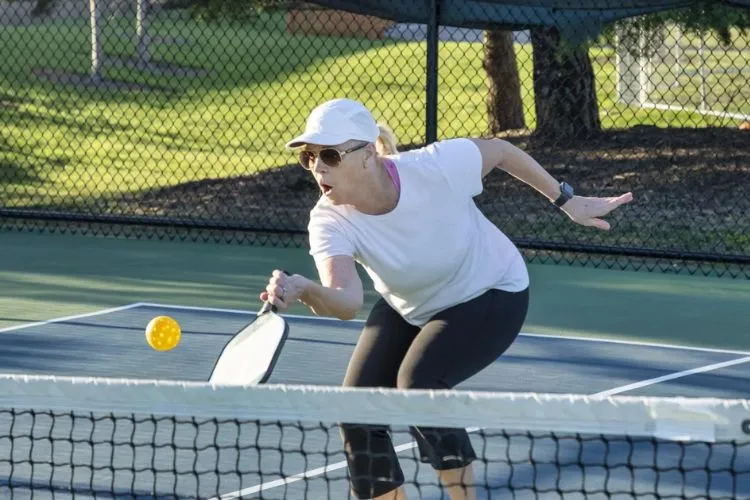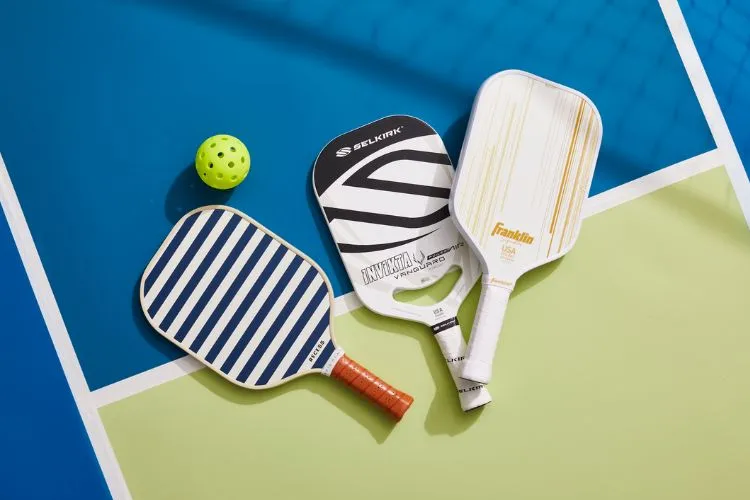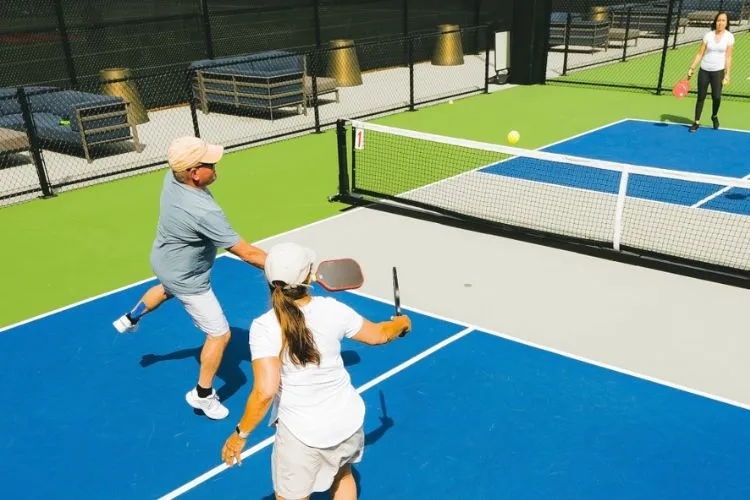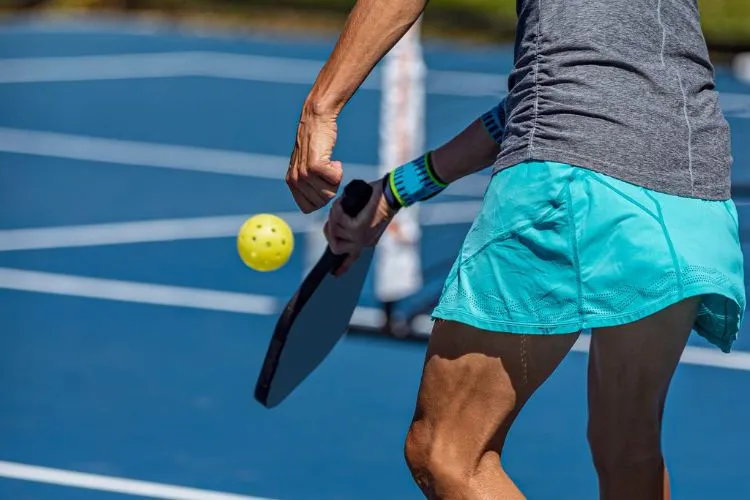Pickleball has gained immense popularity over recent years, spreading across parks, recreation centers, and even tennis courts.
As more people join in on the fun, concerns arise regarding the potential damage caused by playing pickleball to tennis court surfaces. So, is it true? Does the pickleball paddle damage tennis courts?

In this article, we will uncover the truth behind the impact of pickleball paddles on tennis courts, addressing common misconceptions and providing insights into the issue.
By the end, you will have a better understanding of whether pickleball does indeed damage tennis courts and how to prevent and mitigate any potential adverse effects.
Does The Pickleball Paddle Damage Tennis Courts?
Pickleball does not inherently damage tennis courts. While there may be concerns about potential damage, pickleball is generally considered to be gentler on tennis courts compared to other sports.
Proper maintenance and regular inspections can help ensure that the court remains in optimal condition for both tennis and pickleball use. However, it’s important to note that if pickleball lines are marked on a tennis court, there is a possibility of damage to the surface.
Analysis of Pickleball Equipment
To understand the impact of pickleball paddles on tennis courts, we need to analyze the equipment used and compare it to tennis gear. Pickleball paddles are typically lightweight and constructed from materials like graphite or composite.
The lightweight nature of the paddle minimizes the potential force exerted on the court surface compared to a tennis racket. Furthermore, the pickleball itself is made of plastic, which tends to be softer and less abrasive than a tennis ball.

When comparing pickleball equipment to tennis equipment, it becomes evident that pickleball paddles are designed to exert less force and create less friction on courts.
Tennis rackets, in contrast, are often heavier and made from materials like graphite, aluminum, or carbon fiber, while tennis balls are made of felt, which can be more abrasive than plastic.
Impact on Tennis Court Surfaces
Although pickleball paddles and balls are designed to minimize damage, it is crucial to consider the type of tennis court surface in question.
Tennis courts can be made of various materials, including clay, grass, or hard court surfaces like asphalt or concrete. Each surface type has its own durability and susceptibility to marking or damage.
Concrete and asphalt court surfaces are known for their stability and ability to withstand heavy usage and impacts.
In most cases, pickleball play on these surfaces will leave only temporary marks, such as scuffing or rubber streaks, that can easily be cleaned off. These marks typically do not penetrate the court surface or cause long-term damage.
On clay or grass courts, pickleball play may cause slightly more noticeable marks due to the softer nature of these surfaces.
However, given proper maintenance and care, any marks or scuffs can be mitigated. By using maintenance techniques such as dragging or rolling the courts, these marks can often be smoothed out without causing any lasting harm.
Court Usage Guidelines
To ensure responsible gameplay and minimize potential damage to tennis courts during pickleball play, it is crucial for both pickleball and tennis players to follow certain guidelines. By doing so, players can enhance the longevity and quality of court surfaces shared between the two sports.
Responsible gameplay involves being aware of the potential impact on the court and adjusting playing techniques accordingly. For instance, players can avoid dragging or sliding their feet excessively during game play, as this can cause unnecessary scuffing.

Additionally, players should aim to avoid hitting the ball directly on the court surface, as this can result in marks or dents.Best practices for minimizing damage during pickleball play include spreading out the game to different areas of the court.
This helps distribute wear and tear more evenly across the surface, reducing the concentration of damage to specific spots. Furthermore, using pickleball shoes or appropriate footwear can help minimize friction and scuffing.
Expert Opinions and Studies
To gain further insights into the impact of pickleball play on tennis courts, it is valuable to consider the opinions and research of professionals in both the pickleball and tennis communities. Experts often provide comprehensive assessments based on their experience and knowledge.
Research studies have also been conducted to analyze the impact of pickleball play on tennis court surfaces.
These studies have consistently highlighted that proper maintenance and adherence to court usage guidelines significantly minimize any potential damage caused by pickleball, ensuring the longevity and quality of tennis courts.
Preventing and Mitigating Damage
To prevent and mitigate any potential damage caused by pickleball play on tennis courts, various measures can be taken.
Regular maintenance practices for tennis courts, such as sweeping, brushing, and power washing, help remove any dirt or debris that may contribute to additional wear and tear.

Modifications to pickleball equipment, such as using protective tape on paddle edges, can further minimize potential contact with the court surface.
Temporary court solutions, such as overlays or the use of pickleball-specific portable courts, can be used to separate pickleball play from the tennis courts.
Other related articles you may find useful: Pickleball Grips vs Tennis Grips | Are Pickleball Nets The Same Height As Tennis Nets?
Frequently Asked Questions (FAQs)
Can pickleball cause permanent damage to tennis courts?
Pickleball play typically does not cause permanent damage to tennis courts. Most marks or scuffs are temporary and can be easily mitigated through proper maintenance.
Are there any specific court surfaces more prone to pickleball damage?
Concrete and asphalt courts are less vulnerable to damage from pickleball play. Clay and grass courts may experience more noticeable marks but can still be maintained with proper techniques.
How can pickleball players ensure responsible play to minimize potential damage?
Players should avoid excessive dragging or sliding, hitting the ball directly on the court surface, and concentrate wear and tear by spreading gameplay across the court.
Are there any alternative court materials or solutions that prevent damage from pickleball play?
Temporary court solutions, such as overlays or portable pickleball courts, can be used to separate pickleball play from tennis courts, preventing damage.
Conclusion:
After a thorough examination of the impact of pickleball paddles on tennis courts, it becomes clear that pickleball play does not necessarily cause significant damage.
Pickleball equipment is designed to minimize force and friction, and most marks or scuffs are temporary and easily managed through proper maintenance.
By adhering to court usage guidelines and practicing responsible gameplay, both pickleball and tennis enthusiasts can enjoy the shared use of courts without causing lasting harm.

Pickleball’s more than a game to me—it’s a passion. I write, sharing its highs and lows, the thrills and the lessons. Some tales might draw you to the court, while others give a hint of the game’s magic. So, curious about my journey? Ready to dive deep into the world of pickleball with me? Let’s go.
